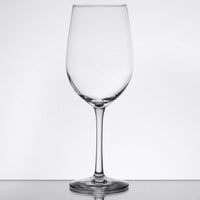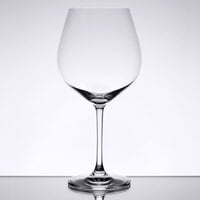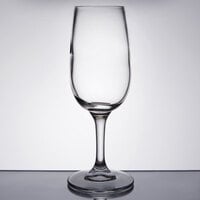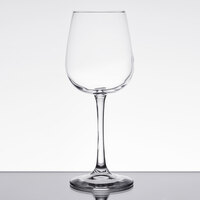
Your Location : Home / News Center >> Common Problem >> Types of Wine Glasses
Types of Wine Glasses
Release time:2017-10-09 Hits: 【Print】

Whether sweet or dry, white or red, robust or light, wine requires very specific serving procedures in order to reach its full flavor potential. In addition to proper serving temperatures, each type of wine requires a specific style of glass for service. Understanding the different types of wine glasses and what makes them ideal for one type of wine over another is essential to getting the most out of your wine collection.
Parts of a Wine Glass

The Foot - Allows your glass to stand upright
The Stem - Allows you to hold your wine glass without the heat from your hands warming your wine, and without creating smudges on the bowl which will distract from the visual enjoyment of your wine
The Bowl – Serves a myriad of purposes; here you'll find the most variation between glasses. The bowls of all wine glasses will be tapered upward with a slightly narrower opening at the top than at the bottom. This shape helps to capture and distribute the wine's aroma toward your mouth and nose.
The bowls of wine glasses are also designed to allow an amount of surface area appropriate to the wine - red wine glasses will have a larger amount of surface area for the wine to allow it to breathe, while white wine glasses will have a smaller amount of surface area. Champagne glasses will have a very small amount of surface area for the wine so that it retains its carbonation
The Rim – Imperative to achieving the full experience from your wines. The thinner the rim, the less the glass distracts from the wine as you sip; a good wine glass will have a "cut" rim that is smooth to the touch and does not inhibit the wine as it flows out of the glass. Less expensive glassware may have rims that are rolled or bumpy – while still functional, and very much practical for everyday use, these wine glasses may distract from the wine itself
The Color – The best wine glasses are crystal clear to allow the beauty and subtleties of the wine to show through. Colored glasses and those with decorative accents may offer a beautiful appearance, however, if showing off your wines, clear glasses are the way to go
Crystal vs. Glass: How to Choose
Wine glasses are typically made out of glass or crystal – but what's the difference? All crystal is glass, but not all glass is crystal. In general, it is the lead content of glass that is the main determinant in the classification of something as either glass or crystal. The presence of lead softens the glass in crystal, therefore making it more easily cut and engraved. It also increases the weight of the glass and causes the glass to diffract light; traditional glass on the other hand is generally lighter in weight than crystal, and light will not diffract through it.
In traditional lead glassware, the lead has a tendency to leach out of the crystal. To combat this, today's crystal glassware is typically unleaded. Unleaded crystal uses barium carbonate and zinc and titanium oxides to replace the traditional lead oxide that's often found in crystal glassware. These glasses feature similar properties as lead crystal, such as temperature control and the ability to accentuate the aroma and flavors of wine. They also feature a similar refractive index to lead crystal, but are lighter in weight.
Although the highest quality crystal glasses are thought to provide a better wine tasting experience, the high cost of these glasses often prevents many from purchasing them. They are also very fragile, so you will experience a higher replacement cost than with thicker plain glass.

Red Wine
Red wines are made from "black" (red-colored) grapes fermented with the skin included. The skin is what imparts the red color to the wine.
Red wines typically have a more robust flavor, and pair well with food that is similarly robust, such as red meats (beef, lamb), hearty pasta dishes, etc. They are usually served at or just below room temperature.
Types of Red Wine:
- Beaujolais
- Bordeaux
- Burgundy
- Cabernet Franc
- Cabernet Sauvignon
- Carignan
- Chianti
- Grenache
- Malbec
- Merlot
- Petite Sirah
- Pinot Noir
- Shiraz
- Zinfandel
Red Wine Glasses
Red wines are best served in large wine glasses, like these red wine glasses. The bowls of these glasses will be fuller and rounder with a larger opening than other wine glasses of similar capacities in order to allow you to dip your nose into the glass to detect aroma. This bowl style is also imperative because the complex aromas and flavors of red wine demand a glass with a larger surface area to ensure that the wine comes in contact with more air.
A specific type of red wine glass, the bordeaux glass, is taller than traditional red wine glasses, yet the bowl is not quite as large. It is designed for full bodied, heavier red wines such as Cabernets and Merlots. The tallness of the glass allows the wine to proceed directly to the back of the mouth to maximize its flavor. Another style of red wine glass, the burgundy glass, is designed for lighter, full-bodied wines such as Pinot Noir. It is not as tall as the Bordeaux glass, but the bowl is larger than the Bordeaux glass, directing the wine to the tip of the tongue to taste its more delicate flavors.
White Wine
White wines are from either "black" (red-colored) or "white" (green-colored) grapes, fermented without the skin, and are often combined with citrus and spicy flavors.
White wines are usually served cold, with lighter foods such as poultry and fish.
Types of White Wine:
- Chardonnay
- Chenin Blanc
- Muscadet
- Muscat Blanc
- Pinot Gris
- Riesling
- Sauvignon Blanc or Fume Blanc
- Semillon
- Viognier
- White Burgundy
- White Bordeaux
White Wine Glasses
A white wine glass' bowl will be more U shaped and upright than that of a red wine glass, allowing the aromas to be released while also maintaining a cooler temperature.
The white wine glass style that’s best for younger whites has a slightly larger opening directing the wine to the tip and sides of the tongue to taste its sweetness.
The glass for more mature white wines will be straighter and taller to dispense the wine to the back and sides of the tongue to taste its bolder flavors.
Sparkling Wine
Sparkling wine, or champagne, adds a hint of luxury, through a fizzy/bubbly texture. The "sparkles" in sparkling wine are bubbles of carbon dioxide, which is a natural byproduct of the fermentation process.
Types of Sparkling Wine:
- Asti
- Cava
- Champagne
- Prosecco
Sparkling Wine Glasses
A sparkling wine glass (or champagne flute) will be upright and narrower than most wine glasses to retain the carbonation and capture the flavor in the beverage.
Rose Wine
Rose wines are pink or blush-colored. The pink color comes from the fact that the grape skin is included for just the first few hours of the fermentation process, or sometimes due to the wine being a mixture of red and white wines. Most rose wines are medium-sweet, especially in the US, but some of the best European roses can be very dry.
Types of Rose Wine:
- Pinot Noir
- Sauvignon
- Zinfandel Blush
Rose Wine Glasses:
Two types of wine glasses are widely accepted for use with rose wines – stemmed glasses with a short bowl and a slight taper, and those with a short bowl and a slightly flared lip. Since these wines are fairly similar in fermentation process as white wines, the use of a white wine glass is also considered acceptable for these types of wine if a rose wine glass is not available.
When selecting a rose wine glass, those with a slightly flared lip are usually preferred for wines that are younger, crisper, and less sweet than the more mature varieties. The flared lip design lets the wine run out of the bowl and right onto the tip of the tongue where the taste buds are most sensitive to sweetness. This allows whatever sweetness is in the wine to be enhanced, giving crisp wines a more balanced flavor and minimizing any bite.
For rose wine that is mature and has a more full-bodied flavor, wine glasses that feature a slight taper are oft preferred. The bowl for mature rose wines is still short and rounded at the bottom, but shaped almost like a shortened red wine glass with a very slight taper.
Dessert Wine and Fortified Wines
Dessert wines are sweet wines and as the name suggests, they are generally served with dessert. Since there are many dessert wine types, a rule of thumb for choosing a wine is that it must be sweeter than the dessert being eaten.
Fortified wine is a wine that has been blended with a liquor. The liquor most often used for this is Brandy which is essentially just distilled wine. This gives fortified wines a distinct flavor and a higher alcohol content than normal wine – usually at least %15 ABV.
Types of Dessert and Fortified Wines:
- Bum Wine
- Ice Wine
- Late-harvest Rieslings
- Madiera
- Marsala
- Noble Rot Wine
- Orange Muscat and other Muscat varieties
- Port
- Raisin Wine
- Sherry
- Vermouth
Dessert and Fortified Wine Glasses
A dessert or fortified wine glass should be smaller to direct the wine to the back of the mouth so the sweetness doesn't overwhelm. Dessert wines generally have a higher alcohol content, making small dessert wine glasses perfect for a smaller serving. The same rule of thumb applies to sherry and cordialglasses.
Specialty Wine Glasses
All Purpose Wine Glasses
If a single glass type is all that your circumstances permit, an all purpose wine glass is the way to go. Although the experience may not be the same as when you use the proper glass type for the application, these glasses offer a similar function at a lower cost and increased efficiency. The bowl shape is in between that of red and white wine glasses, making it acceptable for use with both types of wine.
Stemless Wine Glasses
Offering the same shapes and styles of bowls as traditional stemmed wine glassware, stemless wine glasses deliver function with modern style and a limited risk of breakage. Wines may be warmed faster than with stemmed glasses, but the stemless design of these pieces exudes a contemporary appearance that's all the rage and definitely worth the risk. Additionally, since the delicate stems are no longer present in these glasses, less care ought to be required to maintain them.








